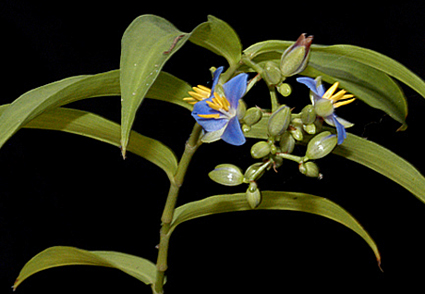Abstract
We describe, discuss, and illustrate Dichorisandra flesheri, a new species endemic to the Atlantic Forest in southern Bahia state, Brazil, based on field and herbarium studies. The species was assessed as ‘Endangered’, especially for its restricted distribution and differs strongly from other species of the genus by a set of characters that includes stem, leaves and inflorescence with a hairy indument, a pendulous inflorescence and flowers with six stamens, anthers slightly sagittate at base, yellowish, opening introrsely with longitudinal slits, but functionally poricidal. Discussion of relevant characters, comparisons with similar species, descriptions, distribution map of the species, information on conservation status and illustrations are provided.
References
- Amorim, A.M., Jardim, J.G., Lopes, M.M.M., Fiaschi, P., Borges, R.A.X., Perdiz, R.O. & Thomas, W.W. (2009) Angiospermas em remanescentes de floresta Montana no sul da Bahia, Brasil. Biota Neotropica 9: 313–348. https://doi.org/10.1590/S1676-06032009000300028
- Amorim, A.M., Thomas, W.W., Carvalho, A.M.V. & Jardim, J.G. (2008) Floristic of the Una Biological Reserve, Bahia, Brazil. In: Thomas, W.W. (Ed.) The Atlantic Coastal Forests of Northeastern Brazil. Memoirs of the New York Botanical Garden 100: 67–146.
- Aona, L.Y.S. (2008) Revisão taxonômica e análise cladística do gênero Dichorisandra J.C.Mikan (Commelinaceae). Doctoral thesis. Universidade Estadual de Campinas, Campinas, Brazil, 310 pp.
- Aona, L.Y.S., Bittrich, V. & Amaral, M.C.E. (2017) Taxonomic novelties in Brazilian Dichorisandra (Commelinaceae): D. sagittata sp. nov. and D. glabrescens stat. nov. Brittonia 69: 209–217. https://doi.org/10.1007/s12228-016-9456-y
- Aona, L.Y.S., Faden, R.B. & Amaral, M.C.E. (2012) Five new species of Dichorisandra J.C.Mikan (Commelinaceae). Kew Bulletin 66: 1–13. https://doi.org/10.1007/s12225-011-9308-6
- Aona, L.Y.S.; Amaral, M.C.E. (2020) Dichorisandra in Flora e Funga do Brasil. Jardim Botânico do Rio de Janeiro. Available from: https://floradobrasil.jbrj.gov.br/FB6924 (accessed 7 September 2023).
- Aona-Pinheiro, L.Y. S. & Amaral, M.C.E. (2012) Four new species of Dichorisandra J.C. Mikan (Commelinaceae) from Southeast Brazil. Phytotaxa 48: 7–22. https://doi.org/10.11646/phytotaxa.48.1.2
- Aona-Pinheiro, L.Y.S., Faden, R.B., Bittrich, V. & Amaral, M.C.E. (2016) Four new species of Dichorisandra (Commelinaceae) endemic from Bahia State, Brazil. Brittonia 68: 61–73. https://doi.org/10.1007/s12228-015-9397-x
- Bachman, S., Moat, J., Hill, A.W., Torre, J. & Scott, B. (2011) Supporting Red List threat assessments with GeoCAT: geospatial conservation assessment tool. In: Smith, V. & Penev, L. (Eds.) e‒Infrastructures for data publishing in biodiversity science. ZooKeys 150: 117–126. https://doi.org/10.3897/zookeys.150.2109
- Faden, R.B. & Hunt, D.R. (1991) The classification of the Commelinaceae. Taxon 40: 19–31. https://doi.org/10.2307/1222918
- Galindo-Leal, C. & Câmara, I.G. (2003) Atlantic Forest hotspot status: an overview. In: Galindo-Leal, C. & Câmara, I.G. (Eds.) The Atlantic Forest of South America. Center for Applied Biodiversity Science, Washington.
- Hickey, M. & King, C. (2004) The Cambridge illustrated glossary of botanical terms. Cambridge University Press, Cambridge, 208 pp.
- IUCN (2019) Standards and Petitions Committee. 2019. Guidelines for Using the IUCN Red List Categories and Criteria. Version 14. Prepared by the Standards and Petitions Committee. Available from: http://www.iucnredlist.org/documents/RedListGuidelines.pdf (accessed 7 September 2023).
- Kunth, K.S. (1843) Omnium Hucusque Cognitarum, Secundum. Familias Naturales Disposita, Adjectis Characteribus, Differentiis et Synonymis. Enumeratio Plantarum 4: 114.
- Mikan, J.C. (1820) Delectus Florae et Faunae Brasiliensis 1: 1–3.
- Mittermeier, R.A., Gil, P.R., Hoffmann, M., Pilgrim, J., Brooks, J., Mittermeier, C.G., Lamourux, J. & Fonseca, G.A.B. (2004) Hotspots Revisited: Earth’s Biologically Richest and Most Endangered Terrestrial Ecoregions. Cemex. Washington, DC.
- Moraes, Q.S., Pellegrini, M.O.O. & Alves-Araújo, A. (2019) A New Species of Dichorisandra (Commelinaceae) with Speckled Leaves from Brazil. Systematic Botany 44: 783–789. https://doi.org/10.1600/036364419X15710776741396
- Myers, N., Mittermeier, R.A., Mittermeier, C.G., Fonseca, G.A.B. & Kent, J. (2000) Biodiversity hotspots for conservation priorities. Nature 403: 853–858. https://doi.org/10.1038/35002501
- Radford, A.E., Dickson, W.C., Massey, J.R. & Bell, C.R. (1974) Vascular plants systematics. Harper & Ro., New York, 891 pp.
- Schultes, J.A. & Schultes, J.H. (1830) Commelinaceae. In: Cottae, J.G. (Ed.) Systema vegetabilium: secundum classes, ordines, genera, species, cum characteribus, differentiis et synonymis. Stuttgardtiae, Sumtibus J.G. Cottae 1817–1830.
- Seubert, M.A. (1855). Commelinaceae. In: Martius, C.F.P. (Ed.) Flora brasiliensis 3: 233–270.
- Shorthouse, D.P. (2010) SimpleMappr, an online tool to produce publication-quality point maps. Available from: https://www.simplemappr.net/ (accessed 13 February 2023).
- Silva, J.M.C. & Casteleti, C.H.M. (2003) Status of the biodiversity of the Atlantic forest of Brazil. In: Galindo-Leal, C. & Câmara, I.G. (Eds.) The Atlantic Forest of South America: biodiversity status, trends, and outlook. Center for Applied Biodiversity Science and Island Press, Washington, pp. 43–59.
- Sousa, L.O.F. & Wendt, T. (2008) Taxonomy and conservation of the genus Lymania (Bromeliaceae) in the southern Bahian Atlantic Forest of Brazil. Botanical Journal of the Linnean Society 157: 47–66. https://doi.org/10.1111/j.1095-8339.2008.00773.x
- Souza, E.H., Aona, L.Y.S., Souza, F.V.D. & Leme, E.M.C. (2021) Lymania involucrata (Bromeliaceae: Bromelioideae), a new ornamental species from Bahia, Brazil. Phytotaxa 489: 209–215. https://doi.org/10.11646/phytotaxa.489.2.9
- Souza, E.H. & Leme, E.M.C. (2021) New Cryptanthus species (Bromeliaceae: Bromelioideae) from the State of Bahia, Brazil. Phytotaxa 523: 179–191. https://doi.org/10.11646/phytotaxa.523.2.5
- Tabarelli, M., Pinto, L.L., Silva, J.M.C., Hirota, M.M. & Bedê, L.C. (2005) Desafios e oportunidades para a conservação da biodiversidade na Mata Atlântica brasileira. Megadiversidade 1: 132–140.
- Taubert, P. (1890) Plantae Glaziovianae novae vel minus cognitae. Botanische Jahrbücher für Systematik, Pflanzengeschichte und Pflanzengeographie, Beibl. 27: 2.
- Thiers, B.M. (2023 [Continuously updated]) Index Herbariorum. New York Botanical Garden’s Virtual Herbarium. Available from: http://sweetgum.nybg.org/science/ih (accessed 20 February 2023)
- Thomas, W.W., Carvalho, A.M.V., Amorim, A.M., Garrison, J. & Arbeláez, A.L. (1998) Plant endemism in two forests in southern Bahia, Brazil. Biodiversity and Conservation 7: 311–322. https://doi.org/10.1023/A:1008825627656
- Veloso, H.P. (1992) Sistema fitogeográfico. In: Manual técnico da vegetação Brasileira. IBGE, Rio de Janeiro. pp. 9–34.
- Veloso, H.P., Rangel-Filho, A.L.R. & Lima, J.C.A. (1991) Classificação da vegetação Brasileira adaptada a um sistema universal. Instituto Brasileiro de Geografia e Estatística (IBGE): Departamento de Recursos Naturais e Estudos Ambientais, Rio de Janeiro.


